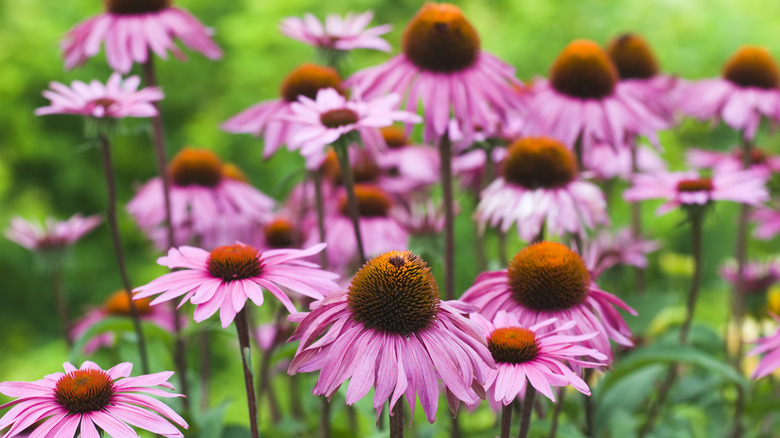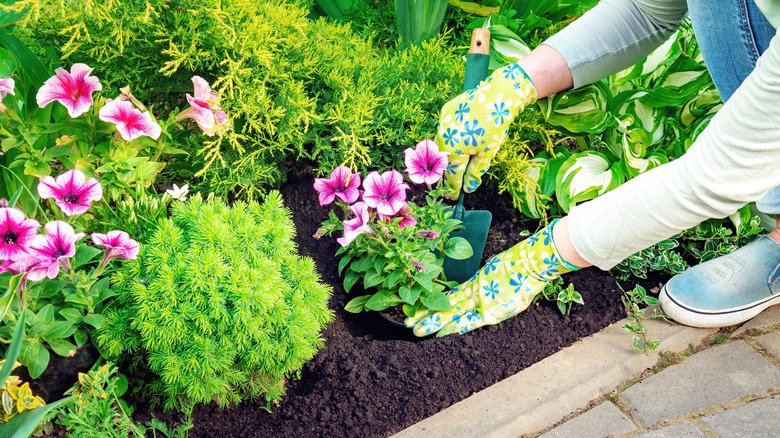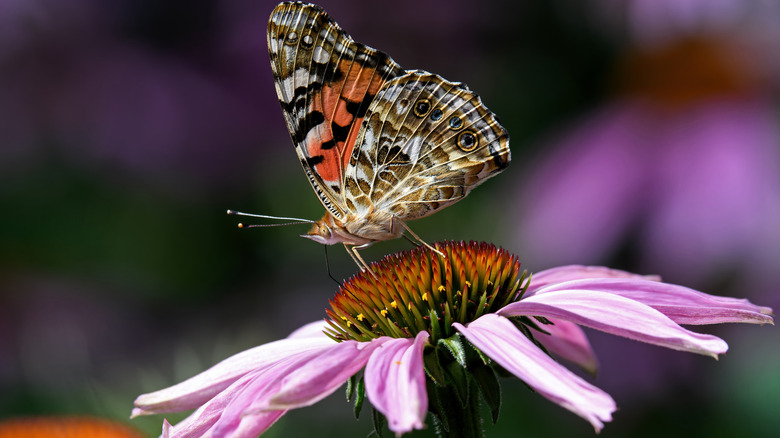Why Coneflowers Are An Excellent Plant To Pair With Petunias In The Garden
Nurturing flowering plants in your home garden is always a rewarding experience. You get to curate your yard with decorative flowers that will spruce up your space with colors, which is one reason why people go for petunias. Petunia flowers are very colorful and shaped like trumpets, making them a go-to candidate for the ornamental garden. Like most other plants, they do even better with a companion plant near them, bestowing unto them good fortune as only a best friend would. Coneflowers (Echinacea) would make an excellent addition to your precious petunias because they attract pollinators like butterflies and birds that will ensure your flowers — and the rest of your garden — proliferate. None of these creatures can resist the delicious temptation of chowing down on the coneflower's seeds.
In addition to being a magnet for pollinators, the coneflower also has an array of other benefits that your petunias can benefit from. Coneflowers are fairly deer-resistant plants. While no plant is completely deer-proof, because deer will wreck any greenery if they're hungry, the purple coneflower (Echinacea purpurea) is classified by the Michigan State University Extension as being Rarely Damaged by deer. By staying within proximity to the coneflowers, petunias can generally avoid being devoured by the foraging ungulates.
Petunias and coneflowers complement each other
To grow coneflowers beside your petunias successfully, you have to know what each plant gives the other. Spacing is important as well as the soil and nutrient requirements which both plant types conveniently share. Petunias love slightly acidic to neutral soil, the exact type that coneflowers typically grow in. Both petunias and coneflowers also prefer full sunlight and well-drained soil. Petunias are an ideal ornamental plant, producing flowers from the springtime into the colder months. You also don't need to worry about competition between these two. Coneflowers aren't very good at competing with other plants. Space these two out by a foot when planting together.
The only problem that would arise from petunias and coneflowers being planted together is that petunias need a lot of nutrition in the form of fertilizer. Coneflowers on the other hand don't like fertilizer as it can result in weed growth. As coneflowers don't handle the competition with other plants very well, this would spell disaster for them. If you have to use fertilizer with petunias, make sure you keep an eye out for weeds and nip them in the bud — literally. Keep in mind that there are various species of petunias and coneflowers and each of them have varying nutritional needs. While they still have most requirements in common, you should still find the balance that works for you.
Coneflowers have a multitude of other benefits, too
Coneflowers may make great companion plants for petunias, but their advantages don't stop there. Coneflowers are a joy to have in the garden, and not just for their bold, beautiful foliage. They are very low-maintenance and do well even if you just leave them alone. They are drought tolerant, so if you're one of those lazy gardeners in the business of forgetting to water your plants, then this is the flower for you. Echinacea plant species also tolerate heat and adverse soil conditions. They strive to survive and would go well with your petunias.
These gorgeous plants have a plethora of benefits for us humans, too. Echinacea is used in medicines that combat the common cold. This wonder plant has permeated many facets of modern medicine and is used to treat bacterial and viral infections, boost the immune system, and lower blood sugar, although studies of these benefits have been inconclusive so far. Regardless, people who practice herbal medicine swear by it.
When it comes to arts and crafts, there is a lot you can do with coneflowers. You can gift the flowers to your loved ones in a brilliant bouquet. They are also great for preserving in resin or glass frames and make for excellent floral decorations.


